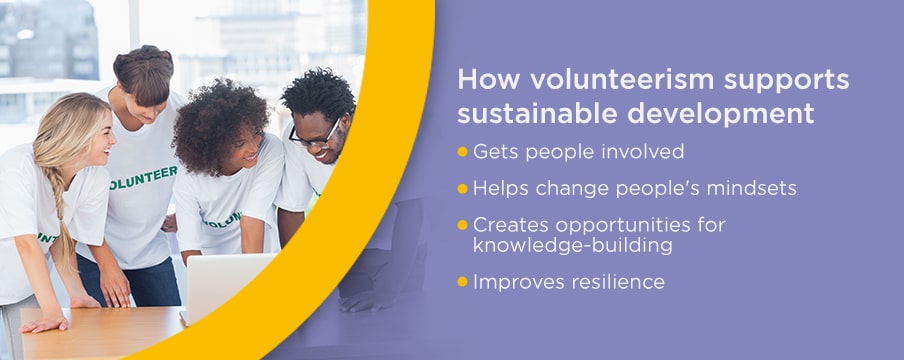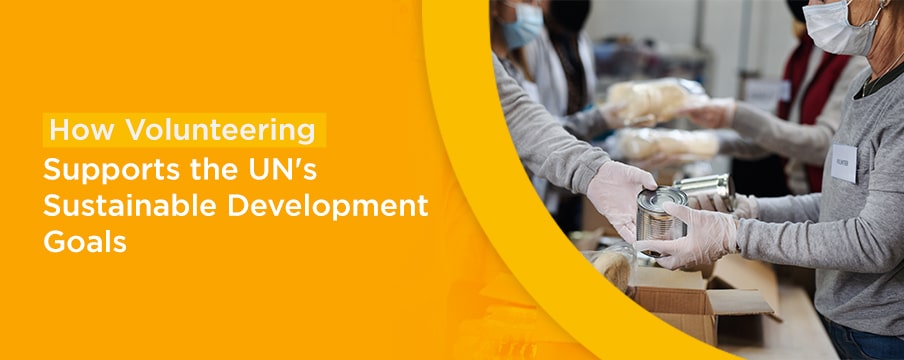If you lead a nonprofit, you likely understand the value of volunteers for your organization. Volunteers make a difference by donating their time and energy to an organization they believe in. But the impacts of volunteering can go beyond fulfilling your organization’s immediate needs. Volunteer work can help make the world a better place for all.
Seventeen Sustainable Development Goals lie at the heart of the UN’s 2030 Agenda for Sustainable Development. Depending on an organization’s mission, volunteerism can help support sustainable development by focusing on one or more of the SDGs. Read on to learn more about these goals for volunteers and the effect they can have.
What are the United Nations’ Sustainable Development Goals?
The 17 SDGs are as follows.
- End poverty: Ending poverty worldwide, in all forms.
- Eliminate hunger: Reach zero hunger, improve nutrition, and ensure sustainable food production.
- Promote health and well-being: Encourage health for people of all ages, including children and pregnant women. Programs can focus on increasing immunizations.
- Provide quality education: Keep children in school and encourage continuing education for all.
- Achieve gender equality: Ensure women and men have the same opportunities and reduce violence against women.
- Provide clean, sanitary water: Deliver clean, safe water to everyone and ensure adequate sanitation facilities are available.
- Make clean energy accessible: Provide affordable and sustainable clean energy to all.
- Promote sustained and sustainable economic growth: Ensure everyone who wants a job can have one, and that available jobs pay a living wage.
- Build infrastructure and foster innovation: Focus on sustainable infrastructure and establishing programs that encourage innovation in communities.
- Reduce inequalities: Level the playing field among countries, reducing the gap between the wealthiest and poorest of citizens.
- Make communities sustainable: Increase access to public green space, improve public transportation, and elevate people out of slums.
- Encourage responsible consumption: Advocate for e-waste recycling, limit reliance on fossil fuels, and promote more sustainable production and distribution methods.
- Take action on the climate: Countries must take urgent action on climate change to reduce the rate at which the world is warming up.
- Improve sea life: Find ways to sustainably use sea life and protect the oceans.
- Improve life on land: Stop desertification, promote sustainable forests, and halt biodiversity loss.
- Promote peace: Ensure everyone has access to justice and develop inclusive societies.
- Revitalize global partnerships: Modernize and stimulate international cooperation.
You can look at the SDGs as a call to action that outlines areas of significant need for ongoing global peace and prosperity. The 17 SDGs seek to make the world a better place for all and support partner countries’ collaboration. Ideally, nations will work on achieving these goals now and in the future.

How volunteerism supports sustainable development
Volunteering can help organizations work to achieve one or more of the UN’s SDGs. When people decide to dedicate some of their time to an organization, they often feel that the work the organization is doing matters. Volunteers can learn and grow with the organizations they partner with, which can further the impact. Take a look at several ways volunteering supports the SDGs and can have a lasting impact on an organization, a volunteer, and the community around them.
Gets people involved
The UN describes its SDGs as an “urgent call to action” that will require the participation of all member nations. The more people who are working on achieving the goals, the better. Involvement with an organization that works to reduce hunger among school-aged children or that creates educational opportunities for girls can be highly rewarding. Organizations can take advantage of the skills and talents a volunteer can bring to the table.
For example, a software developer can volunteer with an organization that creates opportunities for girls. The developer can tutor girls or teach them how to code. Without the participation of the volunteer teacher or tutor, the organization couldn’t fulfill its mission. The developer’s engagement can also raise awareness of the organization. They can tell their colleagues about the program, encouraging others to get involved. The more people get involved, the more opportunities there are for girls, and the smaller the gender inequality gap.
Helps change people’s mindsets
Volunteering can be an eye-opener for many people. They might not fully understand the scale of problems such as hunger, inequality, or poverty until they start working with a particular organization. Once they begin volunteering, they can learn more about a specific topic and often take ownership. They become invested in the cause they’re working for or the issue they’re trying to solve.
In some cases, volunteering can change people’s opinions or beliefs on a topic. For example, a person who decides to volunteer with an aid organization after a natural disaster might see the effect climate change has on our planet and its impact on other people. Their experience as a volunteer, working in the aftermath of a devastating hurricane or tornado, can convince them of the importance of taking action against climate change.
Creates opportunities for knowledge-building
Just as volunteering can help change people’s opinions on specific topics, it also provides opportunities for them to learn and grow. Their growth can also impact the community at large. For example, a person who learns about the life-long effects of childhood hunger while packing sack-suppers for students might then take steps to educate others about the issue. They could organize panel discussions or community events that teach people about the problem.
A volunteer may go even further and decide to study the issue in college or graduate school. A person who volunteers with an organization that preserves marine life might end up becoming a marine biologist, or someone who works with an organization that promotes sustainable design might eventually learn to become an architect who specializes in green design.
Improves resilience
Volunteering can make people more resilient. It also enhances the resilience of the community it serves. For example, when an organization and its volunteers work to end or significantly reduce poverty, they strengthen their community. People brought out of poverty have more options available to them, broadening their horizons and making them stronger.

Optimize your volunteer management with Volgistics
Volunteers are a force for change in the world and contribute to the UN’s SDGs. Volgistics software allows you to build your volunteer base to help your organization support its goals as well as the UN’s SDGs. Its features enable you to recruit and onboard new volunteers and connect with current volunteers. You can use it to schedule shifts or accommodate requests from your volunteer team. Schedule a free demo with Volgistics to see the capabilities of our volunteer management software today!

